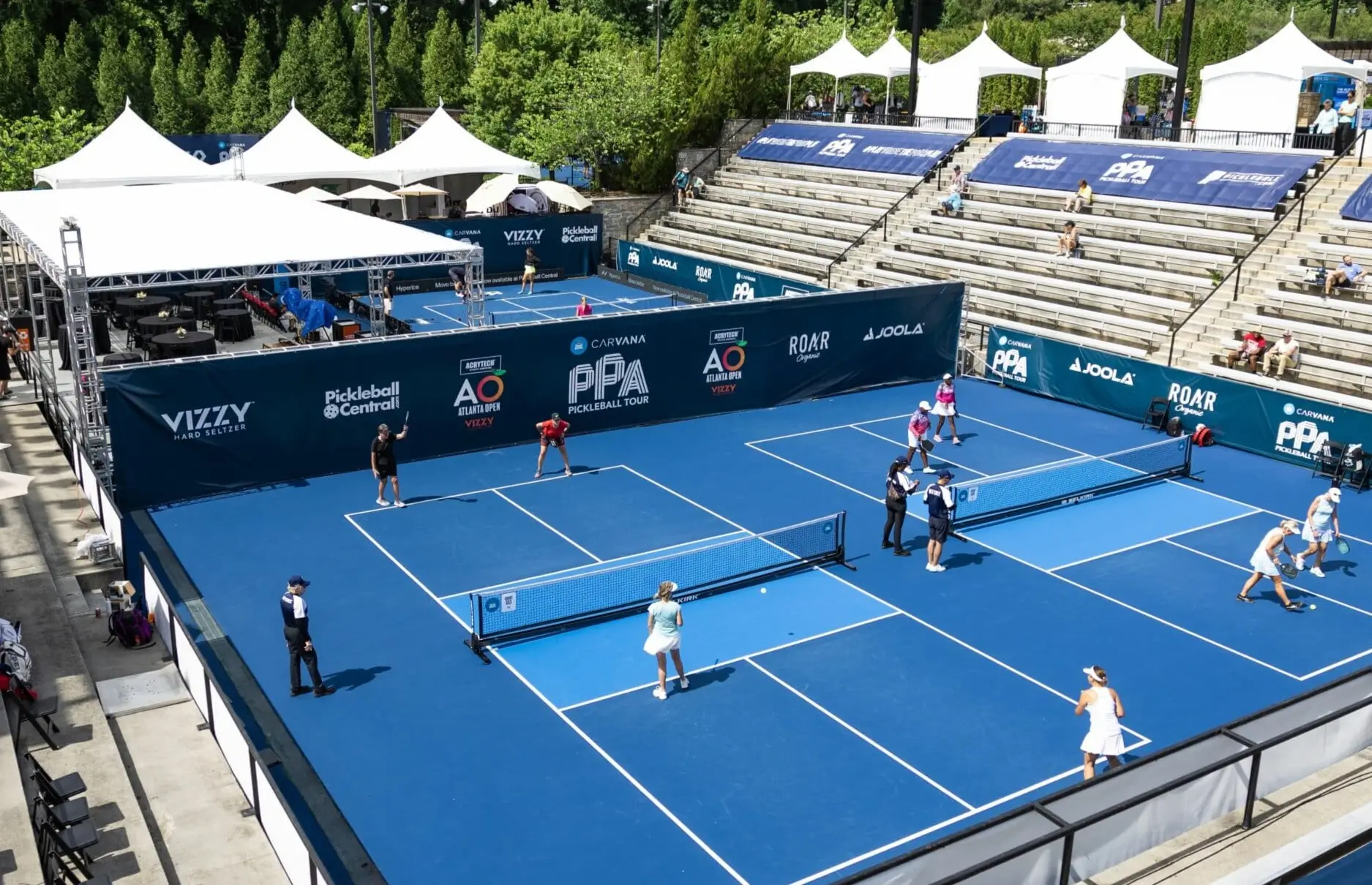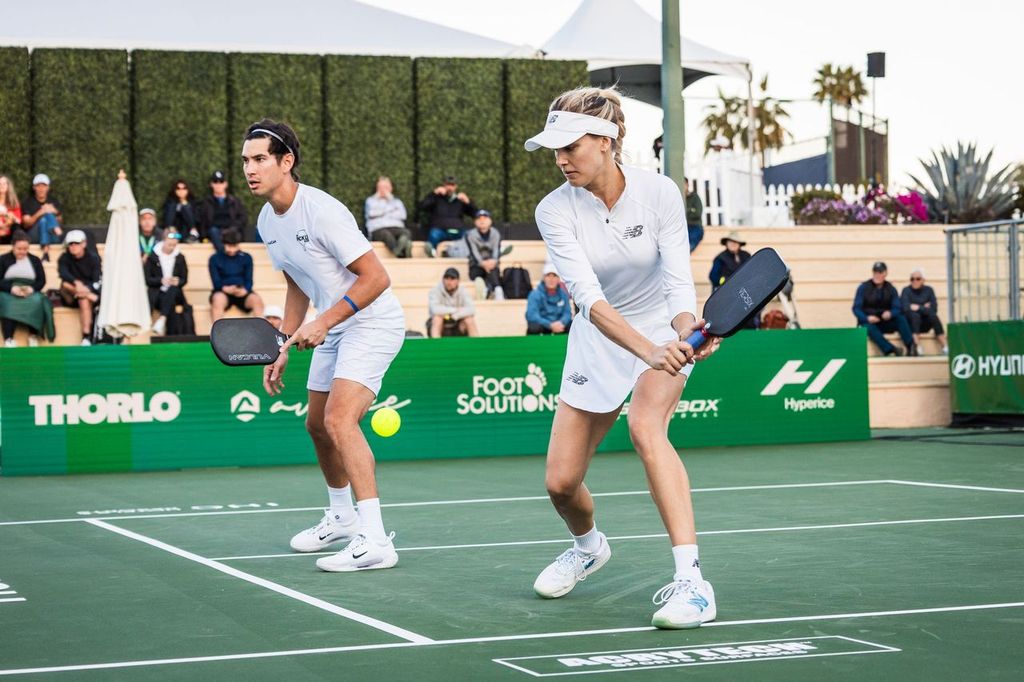How to Find Your Pickleball Rating
| July 11, 2023

There are plenty of different criteria factored into your pickleball rating. Ratings systems are both objective and subjective, because the majority are based on a decimal number, plus a combination of phrases that describe an individual player’s skill-set.
Players can self-rate and assign themselves any level they want when entering their first tournament or players can be evaluated in a number of different scenarios to determine a more accurate rating. Both self-rating and an official rating are deemed acceptable.
If you’re getting set to enter your first tournament or want to join a league or clinic and don’t know what your rating should be, you can start out by self-rating your game. Here’s a simple breakdown of each skill set and the pickleball rating that accompanies it.
1.0 – Player has never played and has no skill-set
2.0 – Player is just starting to play and has no other sports background.
2.5 – Player has limited experience, can sustain a short rally, and is still learning all the rules.
3.0 – Player understands the fundamentals and basic rules, as well as court positioning. They can construct limited points.
3.5 – Player knows the differences between the hard and soft game. They can get to the non-volley zone consistently and are beginning to understand the benefits of “stacking.” They may have an unrelated sports background that helps them learn new skills more quickly.
4.0 – Player is able to identify and attack opponents’ weaknesses, is aware of their partner’s position on the court, and is able to move as a team with their partner. They may have a related racquet sports background that helps them learn new skills rapidly.
4.5 – Player understands strategy, has good footwork, can communicate well, and moves efficiently with their partner. They have both easy and difficult shots in their arsenal, but may not be able to execute them consistently.
5.0 – 8.0 – Player is considered to be “semi-pro” or “pro” if they fall in this category. They have mastered strategy, have all the shots, and can easily play a fast or slow game, as well as employ in-match adaptation and strategy. This is the highest pickleball rating and has a wide range of skill within it, with World #1 Ben Johns holding the highest rating recorded at 7.286 (as of 09/27/2024).
DUPR Ratings
The most popular pickleball rating system is DUPR (Dynamic Universal Pickleball Rating). DUPR is used globally and trusted by the world’s leading clubs, tournaments, leagues, and players.
All players, regardless of their age, gender, or location, are rated on the same scale by DUPR, unifying the pickleball community with a common language. The system is based on a 2.000-8.000 scale, giving players extremely accurate ratings down to the third decimal point.
DUPR helps clubs, tournaments, and leagues create fair and open competition between players of all levels. For players, DUPR offers a free and accurate assessment of skill level, sets goals, tracks player progress, and links players with opponents at the same level for more competitive matchups.
DUPR was the first rating system to allow players to log recreational matches for rating credit, as long as consent is given by all participants. The majority of organized tournaments work with DUPR to automatically log match outcomes for players, but players may also log these matches on their own.
DUPR is the official pickleball rating of leagues, tournaments and clubs around the world, as well as professional and amateur play providers including UPA, PPA Tour, Major League Pickleball, Pickleball.com, Life Time, PICKLR, National Team Pickleball League, and National Pickleball League.
Players and play providers can visit www.dupr.com to sign up for free and learn more.
UTPR Ratings
UTPR is used by USA Pickleball (USAP), and ratings are calculated by your play at USAP sanctioned tournaments only. You will have to join USAP and pay a membership fee to play in a sanctioned tournament.
UTPR ratings include a 4-digit number for tournament seeding purposes and a 2-digit number for more standard usage. Both numbers can be accessed if you’ve played in a USAP tournament by visiting your USAP member profile.
Recreational matches cannot be logged in UTPR. Most tournaments are not USAP sanctioned and do not use UTPR ratings, so the accuracy of UTPR ratings tends to be low. Tournament management providers Pickleball Brackets and Pickleball Tournaments do not work with USAP or UTPR, so playing a tournament through those platforms will not contribute to your UTPR rating.
Another downside to the UTPR rating is that the game scores within matches are not considered. UTPR only records wins and losses, discounting important data such as whether a match was extremely close or a clean sweep.
Skills-Based Guide
Learning some of the technical shots and skills associated with each level can help you determine your rating if you’re new to the sport or have never played a tournament:
A 2.0 player has an understanding of the rules, knows how to keep score, can hit a forehand, backhand, and volley, and can serve accurately into the correct spot. That person also knows where to stand when serving and returning.
A 2.5 player knows the basic rules and the two-bounce rule, can hit a forehand and backhand with direction, is accurate with the serve, is able to sustain a dink rally, can volley with some direction, understands fundamentals, and can accurately keep score.
A 3.0 player can hit a medium-paced forehead and backhand, can serve with depth and accuracy, can control a dink rally, can hit a medium-paced third-shot drop, and can hit a medium-paced volley with direction, as well as understand the fundamentals of the game, positioning, and may have played in tournaments.
A 3.5 player can use a forehand and backhand with a moderate level of control, can consistently get the serve in, return the serve in, can serve deep, and can return the serve deep. This player can also sustain medium-length dink rallies, can control the height and depth of dink shots, and understands the variation of pace for dink shots.
A 4.0 player has all of the skills above and is accurate on overhead shots, can sustain a dink rally with control, height, and pace, consistently executes third-shot drops from the baseline, and is able to change soft shots to power shots and then back to soft. A 4.0 player can also block and return fast, hard volleys and is aware of their partner’s position on the court.
A 4.5 player can do all of the above and can set up shots to generate errors from the other team, recognizes and attempts to hit attackable dinks, poaches effectively, has effective lobs, good footwork, and is comfortable playing at the non-volley zone line as well as understanding strategy and can adjust during the game.
A 5.0 player has all of those skills above and has them mastered, can serve in a variety of ways with power and accuracy, mastered the dink shot, and exhibits patience during a rally.
Whether or not you plan to play a tournament, knowing your skill level will help you navigate friendly games, recreational matches, challenge courts, and league/club play. Playing in games with highly skilled players when you’re a beginner generally isn’t a good time, but finding a game where players are of like skill is rewarding, great exercise, competitively stimulating, and a whole lot of fun. If you know your skill level, you are more likely to feel comfortable and have a better time on court.
If you’re still unsure about your rating, you can reach out to a pickleball coach in your local area and ask them to provide you with a rating.





